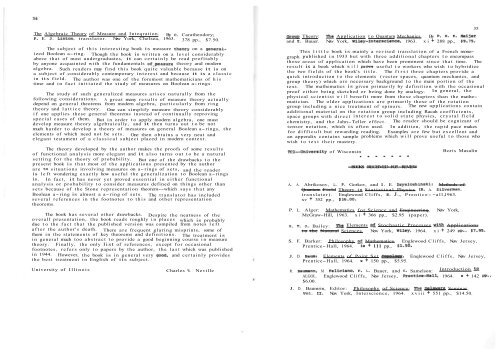Vol. 4 No 1 - Pi Mu Epsilon
Vol. 4 No 1 - Pi Mu Epsilon
Vol. 4 No 1 - Pi Mu Epsilon
Create successful ePaper yourself
Turn your PDF publications into a flip-book with our unique Google optimized e-Paper software.
-The Algebraic Theory of Measure and Inteqration. By C. Caratheodory;F. E. J. Linton, translator. New York, Chelsea, 1963. 378 pp., $7.50.The subject of this interesting book is measure theory on a qeneralizedBoolean a-ring. Though the book is written on a level considerablyabove that of most undergraduates, it can certainly be read profitablyby anyone acquainted with the fundamentals ofmeasure theory and modernalgebra. Such readers may find this book quite valuable because it is ona subject of considerably contemporary interest and because it is a classicin its field. The author was one of the foremost mathematicians of histime and in fact initiated the study of measures on Boolean a-rings.The study of such generalized measures arises naturally from thefollowing considerations. A great many results of measure theory actuallydepend on general theorems from modern algebra, particularly from ringtheory and lattice theory. One can simplify measure theory considerablyif one applies these general theorems instead of continually reprovingspecial cases of them. But in order to apply modern algebra, one mustdevelop measure theory algebraically, and it then turns out to be notmuch harder to develop a theory of measures on general Boolean a-rings, theelements of which need not be sets. One then obtains a very neat andelegant testament of a classical subject placed in modern context.The theory developed by the author makes the proofs of some resultsof functional analysis more elegant and it also turns out to be a naturalsetting for the theory of probability. But one of the drawbacks to thepresent book is that most of the applications presented by the authorare to situations involving measures on a-rings of sets, and the readeris left wondering exactly how useful the generalization to Boolean a-ringsis. In fact, it has never yet proved essential in either functionalanalysis or probability to consider measures defined on things other thansets because of the Stone representation theorem--which says that anyBoolean a-ring is almost a a-ring of sets. The translator has includedseveral references in the footnotes to this and other representationtheorems.The book has several other drawbacks. Despite the neatness of theoverall presentation, the book reads roughly in places which is probablydue to the fact that the published version was compiled from notes leftafter the author's death. There are frequent glaring misprints, some ofthem in the statements of key theorems and definitions. The treatment isin general much too abstract to provide a good beginning course in measuretheory. Finally, the only list of references, except for occasionalfootnotes, refers only to papers by the author, the last which was publishedin 1944. However, the book is in general very good, and certainly providesthe best treatment in English of its subject.University of Illinois Charles W. NevilleTheory: Application to Quantum Mechanics. By P. H. E. Meijerand E. Bauer. New York, Wiley-Interscience, 1963. xi + 288 pp., $9.75.This little book is mainly a revised translation of a French monographpublished in 1933 but with three additional chapters to encompassthose areas of application which have been prominent since that time. Theresult is a book which will prove useful to workers who wish to hybridizethe two fields of the book's title. The first three chapters provide aquick introduction to the elements (vector spaces, quantum mechanics, andgroup theory) which are necessary background to the main portion of thetext. The mathematics is given primarily by definition with the occasionalproof either being sketched or being done by analogy. In general, thephysical scientist will benefit more from these chapters than the mathematician.The older applications are primarily those of the rotationgroup including a nice treatment of spinors. The new applications containadditional material on the rotation group including Racah coefficients,space groups with direct interest to solid state physics, crystal fieldchemistry, and the Jahn-Teller effect. The reader should be cognizant oftensor notation, which is often used. In addition, the rapid pace makesfor difficult but rewarding reading. Examples are few but excellent andan appendix contains sample problems which will prove useful to those whowish to test their mastery.TCI~University of Wisconsin+ + + + * + *----BOOKS RECEIVED FOR REVIEW3 5Boris <strong>Mu</strong>sulinA. A. Abrikosov, L. P. Gorkov, and I. E. ~zyaloshinski: Methods of--Quantum Field Theory in Statistical Physics (R. A. Silverman,translator). Enqlewood Cliffs, N. J., Prentice-~all, 1963.xv + 352 pp., $16.00.P. L. Alger: Mathematics for Science and Enqineerinq. New York,McGraw-Hill, 1963. xi + 366 pp., $2.95 (paper).N. T. J. Bailey: Elements & Stochastic Processes w a Applicationsto the Natural Sciences. New York, Wiley, 1964. xi + 249 pp., $7.95.---S. F. Barker: Philosophy g Mathematics. Englewood Cliffs, New Jersey,Prentice-Hall, 1964. ix + 111 pp., $1.50.J. D. Baum: Elements of Point Set Topoloqv. Enqlewood Cliffs, New Jersey,Prentice-Hall, 1964. x + 150 pp., $5.95.R. Baumann, M. Feliciano, F. L. Bauer, and K. Samelson:Introduction toALGOL. Englewood Cliffs, New Jersey, Prentice- all, 1964. X + 142 PP.,$6.00.J. D. Baumrin, Editor: Philosophy of Science; %Delaware Seminar,vol. 11. New York, Interscience, 1964. xviii + 551 pp., $14.50.
















